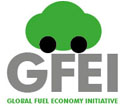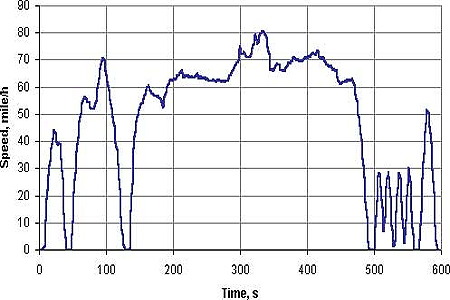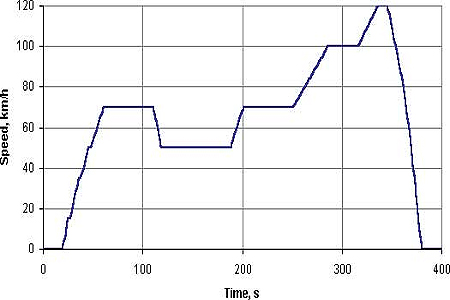
International Test Cycles for Emissions and Fuel Economy
In many countries, cars are tested for fuel economy through standard procedures before being authorised for sale. Automotive fuel consumption is generally measured with a test car running on a chassis dynamometer. However, test methods, including test cycles (i.e. vehicle running patterns) vary among countries and regions. The test cycles simulate a range of driving conditions, at highway speeds and at speeds more typical of urban driving.
A chassis dynamometerIn most developing economies, vehicles are not tested for fuel economy in domestic laboratories, using domestic test cycles. Governments will often rely on published manufacturer data when calculating vehicle stock fuel economy (see the step-by-step guide to baseline setting). In the absence of national tests consumer organizations, such as automobile clubs, are well placed to develop test protocols and conduct or finance testing themselves, publishing results in the interest of their members.
Fuel economy tests for new vehicles differ from region to region. This is appropriate to the extent that typical driving conditions differ by region in a number of respects that affect fuel consumption. This includes prevailing urban versus extra urban driving patterns, ambient temperatures that determine the use of air conditioners, and so on.
The World Forum for Harmonization of Vehicle Regulations of the United Nations Economic Commission for Europe (UN/ECE/WP29) has brought governments and automobile manufacturers together to work on a new harmonised test procedure to be adopted around the world. This may result in an increased focus on urban driving conditions, at least in regions that have low emphasis on these conditions in current tests, but may take years to agree.
Europe, Japan, and the United States have each developed their own test procedures to determine fuel economy and GHG emissions from new passenger vehicles. Below is a comparison of the majority of test procedures used globally.
Below is a comparison of the majority of test procedures used globally.
Cycle |
Length |
Average Speed |
Average |
Max Speed |
Max |
Max Acceleration (Mph/s) |
Max |
EPA Highway |
766 |
48.2 |
77.4 |
59.9 |
96.4 |
3.3 |
5.3 |
EPA City |
1375 |
19.5 |
31.7 |
56.7 |
91.3 |
3.3 |
5.3 |
--- |
--- |
59.9 |
--- |
3.3 |
5.3 |
||
596 |
48.4 |
--- |
80.3 |
--- |
--- |
--- |
|
SC03 |
596 |
21.6 |
--- |
54.8 |
--- |
--- |
--- |
NEDC |
1181 |
20.9 |
33.6 |
74.6 |
120 |
2.4 |
3.9 |
JC08 |
1204 |
15.2 |
24.5 |
50.7 |
81.6 |
3.8 |
6.1 |
This is the 55/45 split of the city and highway cycles that make up the U.S. CAFE measurement.
2 Based on 45/55 CAFE highway/city weighting, not test cycle length
The USO6 and SC03 test cycles are new and will be used to determine fuel economy in 2011, their use is optional from 2008 and later.
The International Council on Clean Transportation (ICCT) has compared various test cycles (NEDC, CAFE, and JC08 test) and has developed a methodology for normalizing fuel economy ratings between cycles. A test cycle conversion tool is also available online and in this Tool.
Simulation results for Gasoline Vehicle Fuel Economy Ratings Under Various Test Cycles
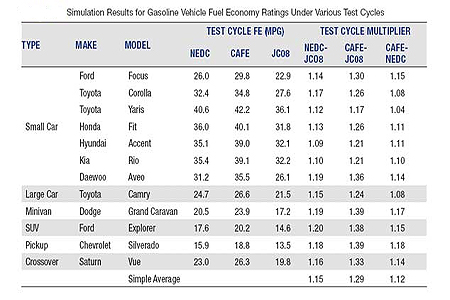
Credit: ICCT 2007
Outlined below are the plots of the test cycles along with a description of those test cycles.
US EPA Test Cycles
The FTP-75 (Federal Test Procedure) has been used for emission certification of light duty vehicles in the U.S. Effective model year 2000, vehicles have to be additionally tested on two Supplemental Federal Test Procedures (SFTP) designed to address shortcomings with the FTP-75 in the representation of (1) aggressive, high speed driving (US06), and (2) the use of air conditioning (SC03).
- 1. cold start phase
- 2. transient phase
- 3. hot start phase.
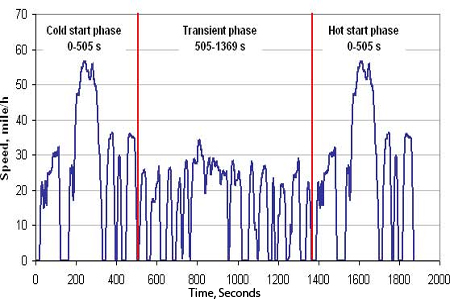
EPA City Cycle Test – For Emissions and City Fuel Economy
The EPA Highway Fuel Economy Cycle is a chassis dynamometer driving schedule, developed by the US EPA for the determination of fuel economy of light duty vehicles.
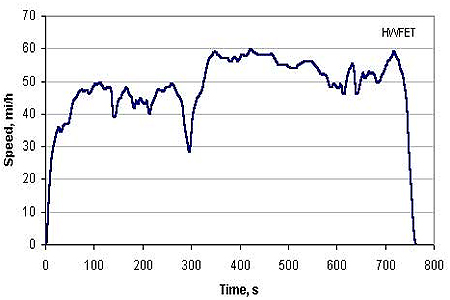
EPA Highway Fuel Economy Cycle
The US06 Supplemental Federal Test Procedure was developed to address the shortcomings with the FTP-75 test cycle in the representation of high speed driving and/or high acceleration driving behavior, speed fluctuations, and driving behavior following startup.
The SC03 Supplemental Federal Test Procedure (SFTP) represents the engine load and emissions associated with the use of air conditioning units in vehicles certified over the FTP-75 test cycle.
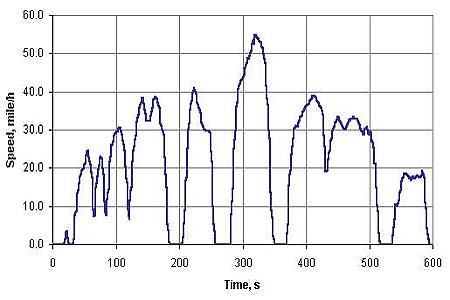
SFTP SC03 Cycle
European Test Cycles
The ECE+EUDC test cycle —also known as the MVEG-A cycle—is used for emission certification of light duty vehicles in Europe.The entire cycle includes four ECE segments, ECE-15, repeated without interruption, and followed by one EUDC segment. Before the test, the vehicle is allowed to soak for at least 6 hours at a test temperature of 20-30°C. It is then started and allowed to idle for 40 seconds.
Effective year 2000, that idling period has been eliminated, i.e., engine starts at 0 seconds and the emission sampling begins at the same time. This modified cold-start procedure is also referred to as the New European Driving Cycle or NEDC.
Emissions are sampled during the cycle according to the “Constant Volume Sampling” technique, analyzed, and expressed in g/km for each of the pollutants.
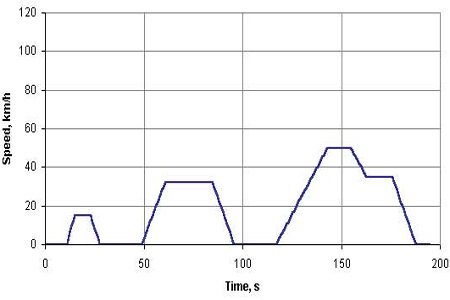
ECE 15 Cycle
The ECE cycle is an urban driving cycle, also known as UDC. It was devised to represent city driving conditions, e.g. in Paris or Rome. It is characterized by low vehicle speed, low engine load, and low exhaust gas temperature. The above urban driving cycle represents Type I test, as defined by the original ECE 15 emissions procedure. Type II test is a warmed-up idle tailpipe CO test conducted immediately after the fourth cycle of the Type I test. Type III test is a two-mode (idle and 50 km/h) chassis dynamometer procedure for crankcase emission determination.
The EUDC (Extra Urban Driving Cycle) segment has been added after the fourth ECE cycle to account for more aggressive, high speed driving modes. The maximum speed of the EUDC cycle is 120 km/h. An alternative EUDC cycle for low-powered vehicles has been also defined with a maximum speed limited to 90 km/h.
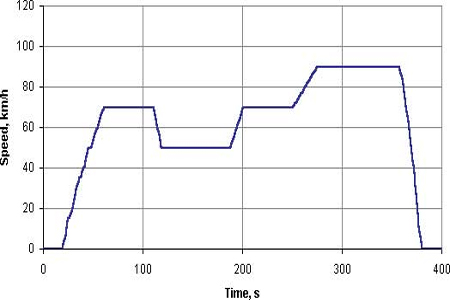
EUDC Cycle for Low Power Vehicles
More on the EU Case Study here.
Australian Test Cycle
The test standard for the current fuel consumption label is specified in ADR 81/01 Fuel Consumption Labelling for Light Vehicles. The label displays the fuel consumption and CO2 values for the vehicle obtained from a standard dynamometer test conducted under laboratory conditions. This test is specified in United Nations Economic Commission for Europe Regulations that set out the procedures for determining fuel consumption and CO2 emissions from light vehicles. The same test is used for the new fuel consumption label.
Japanese Test Cycles
Japanese 2005 emission regulation introduced a new JC08 chassis dynamometer test cycle for light vehicles (< 3500 kg GVW). The test represents driving in congested city traffic, including idling periods and frequently alternating acceleration and deceleration. Measurement is made twice, with a cold start and with a warm start. The test is used for emission measurement and fuel economy determination, for gasoline and diesel vehicles.
The JC08 test will be fully phased-in by October 2011. In the transitional period emissions are determined using weighted averages from different cycles, as follows:
- 2005.10: 12% of 11 mode cold start + 88% of 10-15 mode hot start;
- 2008.10: 25% of JC08 mode cold start + 75% of 10-15 mode hot start;
- 2011.10: 25% of JC08 cold start + 75% of JC08 hot start.
The JC08 driving schedule is schematically shown below.
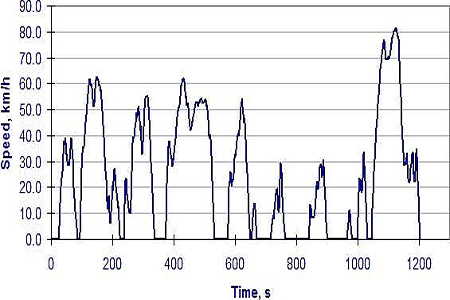
JC08 Test Cycle
The text above is a summary and synthesis of the following sources:
- Building a National Baseline: Practical Guidelines. François Cuenot. International Energy Agency. Presentation in Montenegro, 2012.
- DieselNet. Test cycle plots taken from www.dieselnet.com/standards/cycles
- The International Council on Clean Transportation. Passenger Vehicle Greenhouse Gas and Fuel Economy Standards: A Global Update. July 2007.
